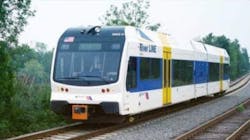Glassboro-Camden Line achieves important milestone
The Glassboro-Camden Line (GCL) light-rail project has achieved a significant project milestone with the completion of a comprehensive Environmental Impact Study (EIS), keeping the project on track to significantly impact transportation in South Jersey.
The EIS was a critical phase that carefully reviewed the project’s environmental impacts. Nationally recognized transportation experts conducted the study with feedback from hundreds of members of the community.
“The GCL project is a vital transportation link for South Jersey, one that is long overdue,” said Jeffrey L. Nash, Camden County commissioner, and Delaware River Port Authority (DRPA) vice chairman. “The GCL will serve to reduce our carbon footprint, increase property values for homeowners, spark economic opportunities for businesses, and provide a convenient means of transportation for workers, students and those who want easy access to the universities, hospitals and cities.”
The GCL is an 18-mile passenger light-rail line that will traverse Gloucester and Camden counties, including the communities of Glassboro, Pitman, Sewell, Mantua Township, Deptford Township, Wenonah, Woodbury Heights, Woodbury, Westville, Brooklawn, Gloucester City and Camden. The GCL restores passenger rail service in a corridor that historically provided this type of service.
The South Jersey Transportation Authority (SJTA) has committed $200 million towards the next phase of the project- preliminary engineering design and project management.
“South Jersey Transportation Authority is pleased to invest in this transformative project,” said Stephen F. Dougherty, SJTA executive director. “This project will reduce traffic congestion, provide greater transportation options, and advance environmental stewardship.”
“The GCL will effectively extend the Philadelphia-Camden metropolitan area,” said John T. Hanson, DRPA CEO and Port Authority Transit Corporation president. “This commuter rail line will provide convenient transportation for workers, students, and those who want easy access to the many cultural, recreational, educational, economic and medical resources on both sides of the river.”


